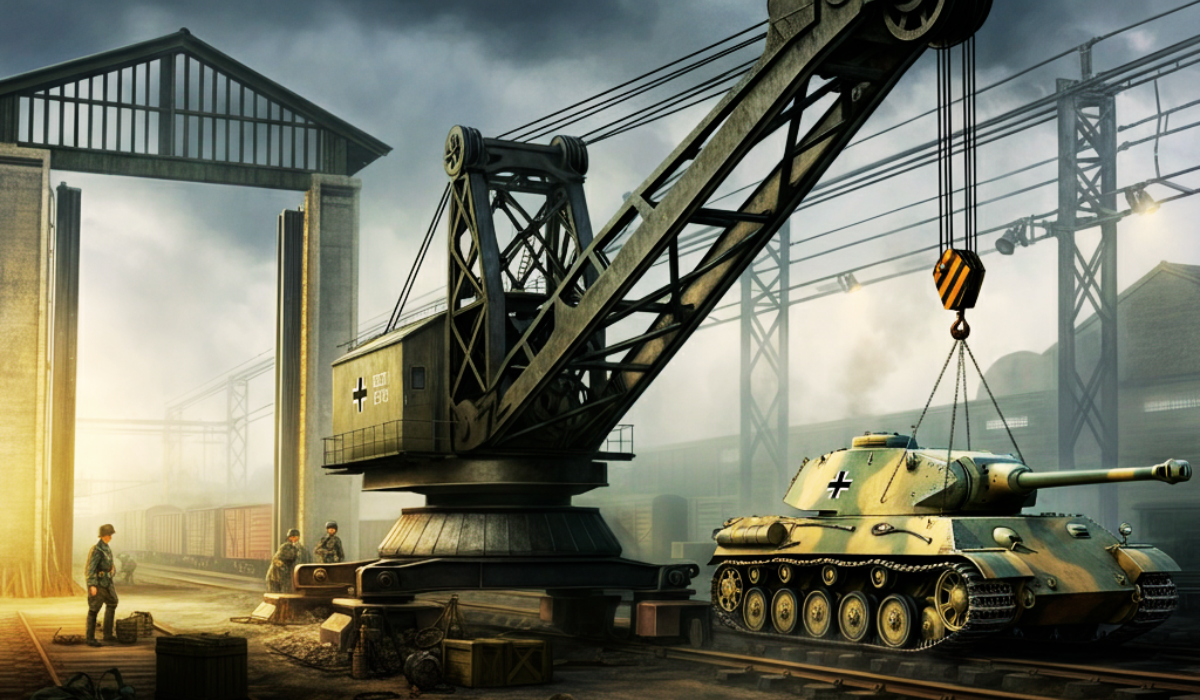The WW2 German Railway Gantry Crane: Engineering Genius Under Fire
During World War II, rapid logistics became a pillar of military success. Armies moved faster, war machines grew, and supply chains were pushed to their limits. Among the machinery created to meet these challenges, the WW2 German railway gantry crane was a remarkable engineering innovation. Built for precision, power, and adaptability, these cranes were pivotal in maintaining heavy weaponry and advancing Germany’s wartime operations.
This blog will explore the development, features, and roles of the German railway gantry crane, most notably the “Strabokran,” and its enduring legacy in engineering.
What Was the WW2 German Railway Gantry Crane?
The WW2 German railway gantry crane, including the iconic Strabokran (“Straßenbockkran” or “road gantry crane”), was a rail-mounted crane system designed to handle heavy military equipment. Built to sustain the demands of a modern, mechanized army, these cranes could lift large tanks, artillery, and even rockets, offering nimbleness and efficiency in wartime logistics.
With collapsible towers and a horizontal gantry, the cranes were engineered for swift assembly and portability, allowing them to be relocated across Germany’s extensive railway system.
Why Were Gantry Cranes Necessary During WWII?
The increasing mechanization of warfare in the 20th century meant that armies relied heavily on tanks, artillery, and other massive vehicles. Maintaining and deploying these machines quickly became a logistical headache. Traditional methods, like manual labor or smaller cranes, couldn’t handle the weight or volume of modern weaponry.
Germany, often known for its engineering prowess, responded by developing gantry cranes, which could handle more than just the weight of equipment. Their precision mechanisms allowed soldiers to repair and maintain assets like the Tiger tank or move advanced technologies like the V-2 rocket with care.
The railway gantry crane became a literal and metaphorical bridge between frontline operations and the infrastructure that supplied them.
Design features of the WW2 German Railway Gantry Crane
These cranes combined brute strength with advanced engineering, creating a tool that was as technically sophisticated as it was functional. What made them so invaluable? Their design held the answers.
1. Heavy Lifting Capacity
The cranes were built to hoist immense loads, typically between 15 and 20 tons. This capability meant they could handle entire tank turrets, engines, or even artillery. Whether it was the massive Tiger tank or railway artillery, the cranes efficiently dealt with these challenges.
2. Mobility via Rail Networks
Mounted on railway cars, the cranes could be rapidly transported to areas most needed. With Germany’s railways forming the backbone of its logistics, these mobile cranes had unparalleled access to frontline supply chains.
3. Precision Engineering
Hydraulic or electric winches allow smooth lifting and placement of heavy objects. This precision ensured that repairs, cargo shifts, or missile placements were necessary when handling equipment as delicate and complex as a tank turret or a V-2 rocket.
4. Durability
Equipped with reinforced steel frameworks, these cranes were made to endure the harsh realities of war. They withstood enemy bombardments, extreme temperatures, and prolonged heavy use.
5. Modularity
The Strabokran models were particularly innovative, with a collapsible design that allowed soldiers to assemble or disassemble the crane within approximately one hour. This feature was critical for rapid redeployment on changing war fronts.
Strategic Roles of the Gantry Crane in WW2
During the war, the gantry cranes were more than just tools. They were force multipliers. They provided German forces the logistical flexibility to sustain war efforts across multiple fronts. Let’s examine their key applications:
1. Tank Maintenance
Tanks like the Panther or the Tiger were mechanical marvels but also prone to breakdowns. These cranes enabled field crews to perform crucial repairs near the front lines by lifting components such as turrets and heavy engines. By speeding up repair times, they kept German armored divisions operational.
2. Munitions Loading
Gantry cranes greatly improved loading and unloading times for munitions and equipment. This efficiency ensured that Germany’s war machines were kept supplied, reducing the strain on supply lines.
3. Support for the V-2 Rocket Program
By 1944, the versatility of the gantry cranes extended to cutting-edge weaponry. Strabokrans were vital in handling A4 (V-2) rockets, loading them onto transport trailers, or positioning them on launch platforms.
The cranes’ ability to seamlessly transition between tasks made them indispensable during the later stages of the war, where advanced weaponry was a key focus.
Challenges and Limitations
Despite all its strengths, the WW2 German railway gantry crane had flaws. The demands of war exposed several key challenges:
- Vulnerability to Airstrikes: Their stationary nature when in use made these cranes vulnerable targets for Allied bombers.
- Dependence on Rail Infrastructure: Their operation was restricted to areas with developed rail networks, which limited their deployment in remote or poorly connected regions.
- Resource Strain: Germany’s shortages of skilled labor and raw materials later in the war impacted production and maintenance.
- Operational Constraints: Setting up the cranes required specialized crews, limiting their utility in emergencies.
While these challenges demonstrated operational constraints, the ingenuity of the design remained evident even in compromised circumstances.
Legacy of the WW2 German Railway Gantry Crane
After the war, the German railway gantry crane left a lasting mark on engineering. Here’s how:
1. Influence on Modern Crane Technologies
These cranes’ modular, heavy-lifting capabilities inspired advances in industrial cranes used in ports and construction. Their mobility and precision engineering remain foundational to modern gantry crane designs.
2. Historical Artifacts
Today, surviving examples of WWII gantry cranes can be found in museums, serving as reminders of wartime innovation and fostering a deeper understanding of engineering under extreme conditions.
3. Lessons for Logistics
For engineers and logistic experts, these cranes highlight how large-scale innovation can adapt to shifting circumstances, offering insights into maximizing efficiency in resource-constrained environments.
FAQ
1. What was the purpose of the WW2 German railway gantry crane?
The gantry crane was used to lift and transport heavy military equipment, such as tanks, artillery, and V-2 rockets, improving mobility and repair efficiency during WWII.
2. What was the lifting capacity of the Strabokran?
The Strabokran could lift loads ranging from 15 to 20 tons, making it suitable for heavy tasks like lifting tank turrets and engines.
3. How were these cranes powered?
The cranes used steam-powered engines or electric motors to generate the lifting force. Hydraulic systems powered the lifting arms for precision movement.
4. Where can I see surviving examples of these cranes?
Surviving examples are often displayed in WWII museums or historic industrial sites as testaments to wartime engineering.
WW2 German Railway Gantry Cranes – A Testament to Innovation
The WW2 German railway gantry crane is an enduring monument to the ingenuity born from necessity. Whether through maintaining tanks, enhancing supply lines, or supporting advanced weaponry like the V-2 rockets, these cranes showcased the impact of engineering excellence on military operations.
Today, they serve not only as relics of history but also as blueprints for modern crane designs. By examining their development, roles, and legacy, we gain insight into how remarkable creations under duress can shape industries long after the conflict has ended.

